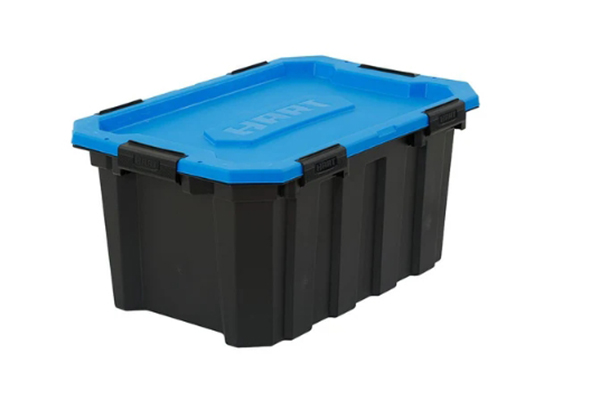Plastic totes are popular storage solutions for a variety of items, from seasonal decorations and clothing to tools and food. They are durable, lightweight, and stackable, making them ideal for organizing and protecting belongings. But when it comes to keeping contents safe from moisture, a common question arises: Are plastic totes waterproof?
While plastic totes are often advertised as being water-resistant or moisture-proof, their ability to fully protect contents from water exposure depends on several factors, including the type of plastic used, the design of the tote, and its seals. In this article, we’ll break down the differences between water-resistant and waterproof plastic totes, the materials and features that influence their performance, and how to best use them for water protection.
What Does Waterproof Mean?
Before diving into the specifics of plastic totes, it’s important to understand what “waterproof” actually means. A waterproof object can be submerged in water without allowing any moisture to enter, no matter how long it’s exposed to water.
In contrast, water-resistant means that an item can resist the penetration of water to a certain degree but is not entirely impervious to it. Water-resistant items may withstand splashes or brief exposure to water, but over time, water can seep through if the exposure is prolonged or the material is compromised.
With this distinction in mind, let’s explore how plastic totes compare to these definitions.

Are Plastic Totes Waterproof?
Generally speaking, most plastic totes are water-resistant, not fully waterproof. This means they can protect contents from light moisture, such as spills, splashes, or brief rain, but they are not designed to be submerged or exposed to large amounts of water for extended periods.
Plastic totes are often made from polypropylene (PP), high-density polyethylene (HDPE), or other types of durable plastic. These materials are naturally resistant to water to a certain extent, meaning they will not absorb moisture, but they are not airtight or sealed. This lack of sealing means that while they can resist some moisture, water can still enter through gaps in the lid or along seams under certain conditions.
Features that Affect Water Resistance
Several design features of plastic totes can affect their ability to resist water. These include:
1. Lid and Seal Design
The lid plays a crucial role in the water resistance of a plastic tote. Standard plastic totes often have lids that snap into place, but these lids usually don’t create an airtight seal. This means that while the lid might keep out some water from spills or rain, it may not fully prevent water from entering if submerged.
Some plastic totes come with gasket seals or rubberized lids, which are designed to create a more airtight and waterproof seal. These totes are generally more effective at preventing moisture from entering and may be marketed as waterproof rather than just water-resistant.
2. Material Thickness
Thicker plastic tends to offer better protection against moisture. Some high-quality plastic totes feature thicker walls, which not only make them more durable but also provide a higher level of water resistance. However, even thicker plastic may not be fully waterproof if the lid does not form a proper seal.
3. Seams and Joints
The seams and joints where the sides of the tote meet the lid can also impact its ability to keep water out. Totes with welded seams (where the plastic is fused together) may offer better resistance to water than those with seams that are merely joined by adhesives or screws. However, if there are gaps or imperfections at these joints, water can seep in over time.
Waterproof Plastic Totes
If you need a truly waterproof tote (able to withstand heavy rain or submersion), look for products specifically designed for this purpose. These totes often feature airtight seals, rubber gaskets, and locking mechanisms to ensure that no moisture can enter. They may also be constructed with more specialized materials, such as thermoplastic elastomers or polyethylene that are engineered to withstand prolonged exposure to water.
Examples of waterproof plastic totes include those designed for outdoor use, such as marine storage bins, dry boxes, or waterproof gear bags used for boating or camping. These types of containers are built to handle extreme conditions and keep contents safe from water damage, making them suitable for storing items like electronics, clothing, and gear that need protection from the elements.
How to Maximize Water Protection with Plastic Totes
If you already own a plastic tote and are concerned about water exposure, there are several ways you can improve its water resistance:
-
Use a Tarp or Waterproof Bag: If you’re storing items that require more protection, you can place them inside a waterproof bag or wrap them in a tarp before putting them in the plastic tote. This adds an extra layer of protection.
-
Choose Totes with Gasket Seals: If you need better water resistance, consider purchasing a plastic tote that includes a rubberized gasket around the lid, which helps form a more secure seal.
-
Avoid Submersion: While plastic totes can handle light moisture, it’s best to avoid submerging them completely in water. Store them in a location where they are not exposed to flooding or excessive rain.
-
Inspect for Cracks or Damage: Regularly check your plastic tote for cracks, holes, or damage along the seams, as these can reduce its water resistance.
Conclusion
In summary, most standard plastic totes are water-resistant rather than fully waterproof. While they can protect your items from minor spills or rain, they are not designed to be submerged or exposed to large amounts of water. If you need to keep contents dry in more extreme conditions, look for totes specifically marketed as waterproof, often featuring sealing mechanisms and heavy-duty materials designed to prevent water from entering.
For everyday storage needs, a plastic tote can be an excellent option for keeping items dry from incidental moisture, but it’s important to understand its limitations and take additional precautions when necessary to ensure your belongings stay safe and dry.
Post time: 02-22-2025



